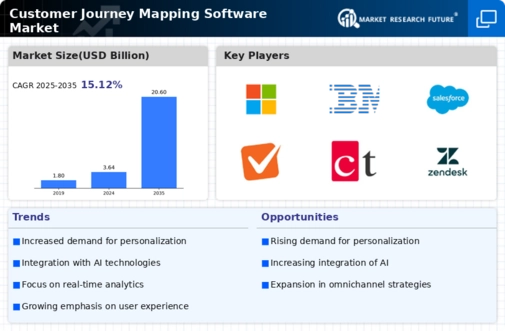Market Growth Projections
Integration of Advanced Technologies
The integration of advanced technologies such as artificial intelligence and machine learning significantly influences the Global Customer Journey Mapping Software Market Industry. These technologies enhance the capabilities of customer journey mapping tools, enabling businesses to analyze vast amounts of data and derive actionable insights. By employing predictive analytics, organizations can anticipate customer needs and tailor their strategies accordingly. This technological advancement not only improves customer engagement but also streamlines operations. As a result, the market is expected to witness a compound annual growth rate of 17.06% from 2025 to 2035, indicating a robust growth trajectory driven by innovation.
Growing Adoption of Cloud-Based Solutions
The shift towards cloud-based solutions significantly impacts the Global Customer Journey Mapping Software Market Industry. Cloud technology offers scalability, flexibility, and cost-effectiveness, making it an attractive option for businesses of all sizes. Organizations can access customer journey mapping tools from anywhere, facilitating collaboration and real-time updates. This trend is particularly beneficial for remote teams and organizations with multiple locations. As more companies migrate to cloud-based platforms, the demand for customer journey mapping software is likely to increase, contributing to the overall growth of the market in the coming years.
Increased Focus on Data-Driven Decision Making
The Global Customer Journey Mapping Software Market Industry is increasingly shaped by the emphasis on data-driven decision making. Organizations are recognizing the value of leveraging data analytics to inform their strategies and improve customer interactions. By utilizing customer journey mapping software, businesses can visualize the entire customer experience and identify areas for improvement. This approach not only enhances customer satisfaction but also optimizes marketing efforts and resource allocation. As companies continue to invest in data analytics capabilities, the demand for customer journey mapping solutions is expected to rise, further propelling market growth.
Rising Demand for Enhanced Customer Experience
The Global Customer Journey Mapping Software Market Industry experiences a notable surge in demand as businesses increasingly prioritize customer experience. Companies recognize that understanding customer interactions across various touchpoints is crucial for fostering loyalty and satisfaction. In 2024, the market is valued at 3.64 USD Billion, reflecting the growing investment in tools that facilitate this understanding. Organizations leverage customer journey mapping software to identify pain points and optimize user experiences, ultimately driving revenue growth. As customer expectations evolve, the industry is poised for substantial expansion, with projections indicating a market size of 20.6 USD Billion by 2035.
Emphasis on Personalization and Customer Engagement
The Global Customer Journey Mapping Software Market Industry is driven by the growing emphasis on personalization and customer engagement. Businesses are increasingly aware that personalized experiences lead to higher customer satisfaction and loyalty. Customer journey mapping software enables organizations to tailor their interactions based on individual preferences and behaviors. By understanding the unique journeys of their customers, companies can create targeted marketing campaigns and enhance overall engagement. This focus on personalization is expected to fuel market growth, as organizations strive to differentiate themselves in a competitive landscape.
























